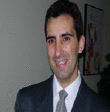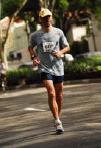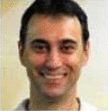Abstract
The aim of this study was to verify the relationship of strength and power with performance on an international level karate team during official kumite simulations. Fourteen male black belt karate athletes were submitted to anthropometric data collection and then performed the following tests on two different days: vertical jump test, bench press and squat maximum dynamic strength (1RM) tests. We also tested power production for both exercises at 30 and 60%1RM and performed a kumite match simulation. Blood samples were obtained at rest and immediately after the kumite matches to measure blood lactate concentration. Karate players were separated by performance (winners vs. defeated) on the kumite matches. We found no significant differences between winners and defeated for strength, vertical jump height, anthropometric data and blood lactate concentration. Interestingly, winners were more powerful in the bench press and squat exercises at 30% 1RM. Maximum strength was correlated with absolute (30% 1RM r = 0.92; 60% 1RM r = 0.63) and relative power (30% 1RM r = 0.74; 60% 1RM r = 0.11, p > 0.05) for the bench press exercise. We concluded that international level karate players’ kumite match performance are influenced by higher levels of upper and lower limbs power production.
Key Points.
Muscle power at low workloads seems to be a reasonable predictor of karate performance.
There are differences in neuromuscular characteristics between winners and defeated karate players among an international level karate team.
Karate players rely more on muscle power, rather than on muscle strength.
Key words: Power, strength, lactate, kumite match
Introduction
Karate competitions are divided into “kata ”(forms) and “kumite ”(match). Kata is characterized by individual and team (three athletes) competitions of standardizes routines, while kumite is a free form of sparring against an opponent. Official karate kumite matches are characterized by 3-minute bouts of high intensity activity involving kicking, punching and quick horizontal displacements (WKF, 2009).
Athletes execute an average of 16.3 ± 5.1 of these decisive actions during the whole match resulting in a total high intensity action time of 19.4 ± 5.5 sec in 3-min matches. Although single kicks and punches are anaerobic alactic and dependent on muscle power, the repetition of these motor actions turns the aerobic pathway the major contributor (77.8% ± 5.8%) to the total energy produced during a kumite match (Beneke et al., 2004). Beneke et al., 2004 also reported that the anaerobic alactic contribution (16.6%) closely represents the time percentage of high intensity actions (16%) during an entire kumite match. However, recovery from these high intensity actions is primary based on aerobic metabolism, and thus explain the large contribution of the aerobic energy pathways for the total energy used.
In addition, anaerobic lactic metabolism can also contribute to the total energy during kumite match. This contribution might be estimated by assessing blood lactate (La) before and after the match. Beneke et al., 2004 showed that La increased 5.9 ± 1.6 mmol·l-1 after a single kumite match (from 1.7 to 7.6 mmol·l-1). Lehmann, 1997 reported similar post kumite match La values. These increases suggest some contribution of the glicolytic metabolism to the total energy expenditure during a kumite match.
Despite the metabolic characteristics of karate, the main criteria to score in kumite matches is the vigorous application of kicks and punches (WKF, 2009). Both actions are performed without external loads and, usually, as fast and powerful as possible. The unique characteristics of the kumite motor actions require a strength assessment that may be able to categorize athletes at distinct competitive levels. For instance, Zehr et al., 1997 observed higher values of loaded (i.e. 10% of their maximal voluntary isometric contraction) and unloaded elbow extension velocity in experienced compared to novice karate players. Further, taekwondo (Toskovic et al., 2004) and judo athletes (Franchini et al., 2005) of different levels show similar 1RM values. Thus, it is possible that karate performance is more dependent on muscle power at low loads than at high loads or on maximal dynamic strength (1RM). Therefore it seems appealing to identify the association of usual power and maximum strength assessments with the kumite performance.
Even though literature presents scattered information regarding strength, power and physiological data (Beneke et al., 2004; Zehr et al., 1997) it is difficult to build a profile of karate players. Moreover, a link between neuromuscular variables and performance results in a competition-like simulation is still lacking. Thus, the aim of this study was to verify the relationship of strength and power with performance on an international level karate team during official kumite match simulations.
Methods
Participants
Fourteen male black belt karate athletes, all members of the Brazilian Karate National Team took part in the study (age 28.0 yrs ± 5.1; height 1.78 m ± 6.6; weight 73.1kg ± 10.5). Participants were tested for power and strength parameters and then paired by weight class for a judged competition-like-simulation. All participants were National Champions and had competed in high level international events (World Championship). These athletes were in a direct dispute for a starting position on the National Team roster, i.e., they were the best two athletes for each category in Brazil. The study was approved by the institutional ethic committee and all subjects were informed of the inherent risks and benefits, before signing an informed consent form. Athletes were tested during their competitive period.
Testing routine
Tests were conducted on two different days at the same time of day. During the first day anthropometric measurements, vertical jump test, and two maximum dynamic strength (1RM) tests (upper and lower limbs) were conducted, while in the second day subjects performed two power tests (upper and lower limbs) and the kumite match simulation. Thirty minutes separated the tests performed on the same day.
Anthropometric measurements
Body weight was measured on a digital scale to the nearest 100g. Skinfold thickness was measured in triplicate with a Harpenden caliper from six body sites (i.e., triceps, brachial, subscapular, suprailiac, abdominal, calf, and thigh). Measurements were made on the right side of the body by the same experienced researcher (10 years experience and less then 1% variation between measurements, with reproducibility determined by and intra-class correlation coefficient of 0.98 within the assessment performance period).
Vertical jump test
Countermovement jumps were performed on a resistive platform attached to a digital timer (JumpTest®, Belo Horizonte, Brazil). Subjects were instructed to keep their hands on the hips and to jump as high as possible maintaining the same body position during take-off and landing. Before the actual test, subjects were allowed to practice between 6 to 10 submaximal jumps. Subjects performed five maximal vertical jumps with 15s interval between trials.
Maximum dynamic strength tests
Maximum dynamic strength (1RM) for squat and bench press exercises was assessed on a Smith machine (Nakagym®, São Paulo, Brazil). For the squat exercise, subject’s body and feet positioning were determined and recorded with measuring tapes fixed on the bar and on the ground, respectively. Then, subjects performed familiarization trials to get acquainted with the test procedures. The procedures for this test respected ASEP guidelines (Brown and Weir, 2001). In short, subjects ran for five minutes in a treadmill at 9 km/h, followed by lower and upper limbs stretching exercises. Before each exercise, subjects should perform a specific warm-up set of 5 repetitions at approximately 50% of the estimated 1-RM followed by another set of 3 repetitions at 70% of the estimated 1-RM. Warm-up sets were separated by a 2-minute interval. After the completion of the second set, subjects rested for 3 minutes. Subsequent lifts were single repetitions of progressively heavier loads, until failure. Maximum dynamic strength (1RM load) was determined as the maximum weight that could be lifted once with proper technique. The interval between 1RM attempts was set at 3 minutes, and a maximum of 5 attempts were allowed. Test was accompanied by two experienced researchers. Increments in weight were determined according to researchers’ perception. Strong verbal encouragement was provided during all lifts.
Bench press 1RM was assessed with the subjects lying on a horizontal bench. Body and hand positioning on the bench and on the bar were recorded and the test was performed according to the same procedures described above.
Power tests
The power produced during the squat and bench press exercises was assessed on a Smith machine (Nakagym®, São Paulo, Brazil). A linear encoder (Peak Power®, Cefise, São Paulo, Brazil) was attached to the equipment’s bar to register its position through the repetitions at a frequency of 50 Hz. Finite differentiation technique was used to estimate bar velocity and acceleration (variability coefficient <3%). Then, force and power were calculated using standard procedures (Bosco et al., 1995). Body, foot (squat) and hand (bench press) positioning were reproduced using the previously recorded positions. In addition, during the squat a wood seat with adjustable heights was placed behind the subjects to keep bar displacement and knee angle constant on each repetition; for the bench press a 3cm foam was placed on subject’s chest to ensure that bar traveling depth was kept constant (since the bar should touch the foam in each repetition). Both squat and bench press power production was assessed through a six repetition set, using two different loads, 30 and 60% of correspondent 1RM values for each exercise.
Kumite simulated match
In order to address the relationship between the physiological parameters and performance, a judged championship-like kumite match was performed. As mentioned before, subjects were paired according to their weight classes. The subjects were instructed to maintain their usual preparation routine for a competition event. After a warm up period, the kumite was designed in an identical way to the corresponding matches of the Pan American Games of 2007 (i.e. 3 minutes bouts, with timing starting and stopping at each referees’ signal) (WKF, 2009).
Blood sampling and lactate analysis
Blood samples (25µl) were obtained at rest and immediately after the kumite matches at the earlobe after application of a vasodilator pomade. Lactate was analyzed using a portable lactate analyzer (Accusport, Boehringer Mannheim, Germany), which has been validated by comparing it with usual laboratory methods with similar results (Fell et al., 1998).
Statistical analysis
After the match, subjects were separated by performance (winners vs. defeated) on the kumite simulated match. Independent t- tests were performed for between group comparisons. Correlation between variables was assessed by a Pearson’s correlation coefficient. Significance level was set at p < 0.05.
Results
No significant differences were found between winners and defeated for strength, vertical jump height and anthropometric data. Table 1 presents anthropometric values separated by group.
Table 1.
Anthropometric characteristics of male international level karate players. Data are means (±SD).
| Winners | Defeated | |
|---|---|---|
| Age (yrs) | 27.9 (5.7) | 28.1 (4.9) |
| Weight (kg) | 74.3 (13.3) | 71.9 (7.8) |
| Height (m) | 181.6 (4.9) | 174.8 (6.5) |
| SKF (mm) | 69.0 (30.9) | 59.6 (29.1) |
SKF = skinfold thickness summation
Table 2 presents jump height, strength and power data for both groups. Statistical analysis showed significant differences between winners and defeated athletes for bench press and squat power using 30% 1RM, while no difference was found at 60% 1RM (Table 2). Blood lactate (La) values obtained pre and kumite matches are also presented in Table 2. Statistical analysis did not show significant differences between winners and defeated for La.
Table 2.
Jump height, strength, power, lactate and heat rate values of male international level karate players. Data are means (±SD).
| Winners | Defeated | |
|---|---|---|
| Jump Height (cm) | 48.8 (3.4) | 50.8 (2.6) |
| 1RM Bench Press (Kg) | 76.3 (16.8) | 70.3 (11.5) |
| 1RM Squat (kg) | 113.3 (15.1) | 128.6 (20.4) |
| PP 30% Squat (W) | 298.7 (6.4) * | 269.5 (23.1) |
| PP 60% Squat (W) | 331.3 (17.6) | 345.0 (29.9) |
| PP 30% Bench Press (W) | 252.6 (9.1) * | 205.7 (5.9) |
| PP 60% Bench Press (W) | 152.6 (9.1) | 156,2 (7.7) |
| La Pre (mmol·l-1) | 2.3 (0.4) | 1.8 (0.6) |
| La Post (mmol·l-1) | 5.1 (1.2) | 5.2 (2.2) |
* p < 0.05 between winners and defeated
The sum of skinfold thickness were significantly and negatively correlated to both jump height (r = -0.69, p < 0.05) and squat power at 60% 1RM (r = -0.54, p < 0.05). Maximum strength was correlated with absolute (30% 1RM r = 0.92; 60% 1RM r = 0.63) and relative power (30% 1RM r = 0.74; 60% 1RM r = 0.11, p > 0.05) for the bench press exercise.
Discussion
The objectives of this study were to identify and to correlate performance in a championship-like kumite match to strength and power parameters in the Brazilian national karate team. Our main findings were that despite the lack of differences in 1RM values, winners presented greater lower and upper limbs power than defeated karate players.
Strength
The 1RM values for both bench press and squat exercises are lower than previously reported in Japanese karate athletes (Imamura et al., 1998), but higher than the values reported in taekwondo players (Toskovic et al., 2004). However, caution should be exercised when interpreting these data, since the neuromuscular and physiological demands may vary between martial arts.
On the other hand, regarding the kumite performance, 1RM values were similar between winners and defeated in our study, which is quite similar to that reported when comparing experienced and novice taekwondo players (i.e., no difference between groups) (Toskovic et al., 2004) and in high level judo players (Franchini et al., 2005). Taken together, these results lead us to suggest that maximal dynamic strength is not critical to karate performance and that other variables probably play a more important role than maximal dynamic strength. It is also worth to notice that none of the evaluated athletes in our study were engaged in regular strength training programs.
Vertical jump and power tests
Although the vertical jump test is not specific, it is widely used as a good indicator of lower limbs power. Thus it might be interesting to correlate lower limbs power with performance. Nevertheless, we found no differences in vertical jump performance between winners and defeated players. Ravier et al., 2004 observed greater vertical jump values for international level junior karate athletes when compared to national level athletes. However, the vertical jump results presented here are higher than those observed in taekwondo (Toskovic et al., 2004) and national or international level karate athletes (Ravier et al., 2004).
Decisive actions in a karate match, a kick or a punch, are dependent on muscle power. Considering that power is the product of force and velocity, higher power represents a higher velocity at the same relative load. The significant difference found in power with low workload (30% 1RM) between winners and defeated players (Table 2) is of great interest, since score awarding depends on the power and the speed of an action (WKF, 2009). Therefore greater power at low loads would represent a greater punching or kicking velocity.
It is known that karate players training routine consists of performing unloaded punches and kicks ( Funakoshi, 1990; Nakayama, 1983), which can induce a greater adaptation in the velocity portion of the force-velocity curve and result in greater segment velocity. Moreover, as no differences were found between groups for maximal force, it is reasonable to assume that karate actions relies more on contraction velocity than on muscle strength.
When comparing international and national level junior karate players, Ravier et al., 2004 found that international level athletes presented higher maximal power output, maximal velocity and optimal velocity values on a friction braked cycle ergometer. According to the authors, the data suggest that movement velocity variables could help explain performance in explosive actions involved in karate.
Of note, an anthropometric variable may affect movement velocity. A lower skinfold thickness is a desirable anthropometric characteristic since it means less non-power producing mass (fat), and thus it would represent a lighter body mass to be moved, allowing a higher segment velocity to be achieved. The negative correlations found between this variable and jump height or power performance during squat exercise reinforce our suggestion. The skinfold thickness results in the present study (Table 1) showed no difference between winner and defeated groups, but are higher than previously published data for taekwondo athletes (36.7 ± 6.8 mm) and boxers (38.1 ± 7.4 mm), using similar methods (Pieter, 1991).
Unfortunately, it is very difficult to elaborate an appropriate test that closely mimics karate skills and still evaluate motor abilities. Nevertheless, it seems that the tests used were able to identify better karate match performers. However, caution must be used as further investigations are necessary in order to establish the suitability of the proposed tests in predicting karate performance or performance improvement during prolonged training periods.
Simulated kumite match
Few studies evaluated karate athletes performing kumite match simulations (Beneke et al., 2004; Iide et al., 2008) or competitions (Lehmann, 1997), and unfortunately we did not find any study which compared the La responses or the physical fitness of karate players with the results of a match simulation (i.e., winners versus defeated). Therefore, it is difficult to compare our results with previous studies.
The La response in the present study is at an intermediate level compared to previous investigations (Beneke et al., 2004; Iide et al., 2008; Lehmann, 1997). The non significant difference between groups for La indicates that the metabolic demands were similar between groups and this specific physiological variable does not play a major role in kumite outcome. Additionally, except for one study (Iide et al., 2008), La values obtained after simulations or competitions are considerably higher than those reported during typical karate training sessions (Imamura et al., 1999; 2002). These data indicates that a “typical ”training routine may not attend the metabolic demands of kumite competition.
Finally, as discussed previously, the ability to produce power seems to better explain kumite results. The finding that winners produced 23% more upper limb power at 30% 1RM than defeated is in accordance with findings reporting that experienced karate players present higher values of peak elbow extension velocity (either unloaded or with loads equal to 10% MVIC) (Zehr et al., 1997). Such characteristic may reflect a greater punching ability (faster movements), thus resulting in better kumite performance. In fact, personal communication from the Brazilian national karate team head coach indicates that during the last Pan American Games (Rio de Janeiro, 2007), approximately 80% of the points awarded to his players were originated from punching. Also, the greater lower limb power at low workload displayed by the winner group (11%) may account for better kicking and moving ability, which ultimately may result in increased performance.
Conclusion
In our study, significant differences were observed for power production for both lower and upper limbs. Although not assessed, it is reasonable to assume that technical level was similar among our participants, since they were the best two athletes of their category in the country.
Therefore, it is possible to conclude that mechanical factors (power) play an important role in karate performance and that international level karate players’ kumite match performance is influenced by higher levels of upper and lower limbs power production. Moreover, the real world power tests used in the present study seemed to differentiate performance level among top level karate athletes.
Acknowledgement
We would like to thank the Brazilian Karate Federation.
Biographies

Hamilton ROSCHEL
Employment
Researcher at the School of Physical Education and Sport of the University of São Paulo, Laboratory of Neuromuscular Adaptations to Strength Training.
Degree
PhD
Research interests
Neuromuscular adaptations to strength training, training periodization and therapeutical effects on muscle diseases.
E-mail: hars@usp.br

Mauro BATISTA
Employment
Researcher at the School of Physical Education and Sport of the University of São Paulo, Laboratory of Neuromuscular Adaptations to Strength Training.
Degree
PhD
Research interests
Whole body vibration training.
E-mail: maurobatista@usp.br

Rodrigo MONTEIRO
Employment
Researcher at the School of Physical Education and Sport of the University of São Paulo, Laboratory of Neuromuscular Adaptations to Strength Training.
Degree
MSc
Research interests
Neuromuscular adaptations to strength training.
E-mail: rodrigofonseca@usp.br

Rômulo BERTUZZI
Employment
Researcher at the School of Physical Education and Sport of the University of São Paulo, Laboratory of Neuromuscular Adaptations to Strength Training.
Degree
PhD
Research interests
Metabolism and quantification of energetic systems contribution during exercise.
E-mail: bertuzzi@usp.br

Renato BARROSO
Employment
Researcher at the School of Physical Education and Sport of the University of São Paulo, Laboratory of Neuromuscular Adaptations to Strength Training.
Degree
MSc
Research interests
Neuromuscular adaptations to strength training, muscle damage and its relationship with eccentric muscle actions.
E-mail: barroso@usp.br

Irineu LOTURCO
Employment
Physical trainer of the Brazilian National Karate Team.
Degree
MSc
Research interests
Neuromuscular adaptations to strength training.
E-mail: irineu.loturco@terra.com.br

Carlos UGRINOWITSCH
Employment
Ass. Prof. of the Depart. of Sport of the School of Physical Education and Sport of the University of São Paulo, Coordinator - Laboratory of Neuromuscular Adaptations to Strength Training
Degree
PhD
Research interests
Neuromuscular adaptations due to resistance training, training periodization.
E-mail: ugrinowi@usp.br

Valmor TRICOLI
Employment
Associate Professor of the Department of Sport of the School of Physical Education and Sport of the University of São Paulo - Coordinator - Laboratory of Neuromuscular Adaptations to Strength Training
Degree
PhD
Research interests
Neuromuscular adaptations to strength training.
E-mail: vtricoli@usp.br

Emerson FRANCHINI
Employment
Assistant Professor of the Department of Sport of the School of Physical Education and Sport of the University of São Paulo
Degree
PhD
Research interests
Exercise physiology, with focus on high intensity intermittent exercise, sport-specific tests and combat sports.
E-mail: emersonfranchini@hotmail.com
References
- Beneke R., Beyer T., Jachner C., Erasmus J., Hutler M. (2004) Energetics of karate kumite. European Journal of Applied Physiology 92, 518-523 [DOI] [PubMed] [Google Scholar]
- Bosco C., Belli A., Astrua M., Tihanyi J., Pozzo R., Kellis S., Tsarpela O., Foti C., Manno R., Tranquilli C. (1995) A dynamometer for evaluation of dynamic muscle work. European Journal of Applied Physiology Occupational Physiology 70, 379-386 [DOI] [PubMed] [Google Scholar]
- Brown L.E., Weir J.P. (2001) ASEP Procedures recommendation I: Accurate assessment of muscular strength and power. Journal of Exercise Physiology (online) 4, 21 [Google Scholar]
- Fell J.W., Rayfield J.M., Gulbin J.P., Gaffney P.T. (1998) Evaluation of the Accusport Lactate Analyser. International Journal of Sports Medicine 19, 199-204 [DOI] [PubMed] [Google Scholar]
- Franchini E., Takito M.Y., Kiss M.A.P.D.M., Sterkowicz S. (2005) Physical fitness and anthropometric differences between elite and nonelite judo players. Biology of Sport 22, 315-328 [Google Scholar]
- Funakoshi G. (1990) Karate-do Kyohan. 2nd edition Kodansha International, Tokyo [Google Scholar]
- Iide K., Imamura H., Yoshimura Y., Yamashita A., Miyahara K., Miyamoto N., Moriwaki C. (2008) Physiological responses of simulated karate sparring matches in young men and boys. Journal of Strength Conditioning Research 22, 839-844 [DOI] [PubMed] [Google Scholar]
- Imamura H., Yoshimura Y., Nishimura S., Nakazawa A.T., Nishimura C., Shirota T. (1999) Oxygen uptake, heart rate, and blood lactate responses during and following karate training. Medicine and Science in Sports and Exercise 31, 342-347 [DOI] [PubMed] [Google Scholar]
- Imamura H., Yoshimura Y., Nishimura S., Nakazawa A. T., Teshima K., Nishimura C., Miyamoto N. (2002) Physiological responses during and following karate training in women. Journal of Sports Medicine and Physical Fitness 42, 431-437 [PubMed] [Google Scholar]
- Imamura H., Yoshimura Y., Uchida K., Nishimura S., Nakazawa A. T. (1998) Maximal oxygen uptake, body composition and strength of highly competitive and novice karate practitioners. Applied Human Science 17, 215-218 [DOI] [PubMed] [Google Scholar]
- Lehmann G. (1997) La resistenza negli sport di combattimento. SDS/Rivista di Cultura Sportiva 16, 19-25 (In Portegul) [Google Scholar]
- Nakayama M. (1983) Dynamic karate. 1st edition Kodansha International, Tokyo [Google Scholar]
- Pieter W. (1991) Performance characteristics of elite taekwondo athletes. Korean Journal of Sport Science 3, 94-117 [Google Scholar]
- Ravier G., Grappe F., Rouillon J.D. (2004) Application of force-velocity cycle ergometer test and vertical jump tests in the functional assessment of karate competitor. Journal of Sports Medicine and Physical Fitness 44, 349-355 [PubMed] [Google Scholar]
- Toskovic N.N., Blessing D., Williford H. N. (2004) Physiologic profile of recreational male and female novice and experienced Tae Kwon Do practitioners. Journal of Sports Medicine and Physical Fitness 44, 164-172 [PubMed] [Google Scholar]
- WKF (2009) World Karate Federation - Kata and Kumite Competition Rules. 6th edition WKF, Madrid [Google Scholar]
- Zehr E.P., Sale D.G., Dowling J.J. (1997) Ballistic movement performance in karate athletes. Medicine and Science in Sports and Exercise 29, 1366-1373 [DOI] [PubMed] [Google Scholar]


